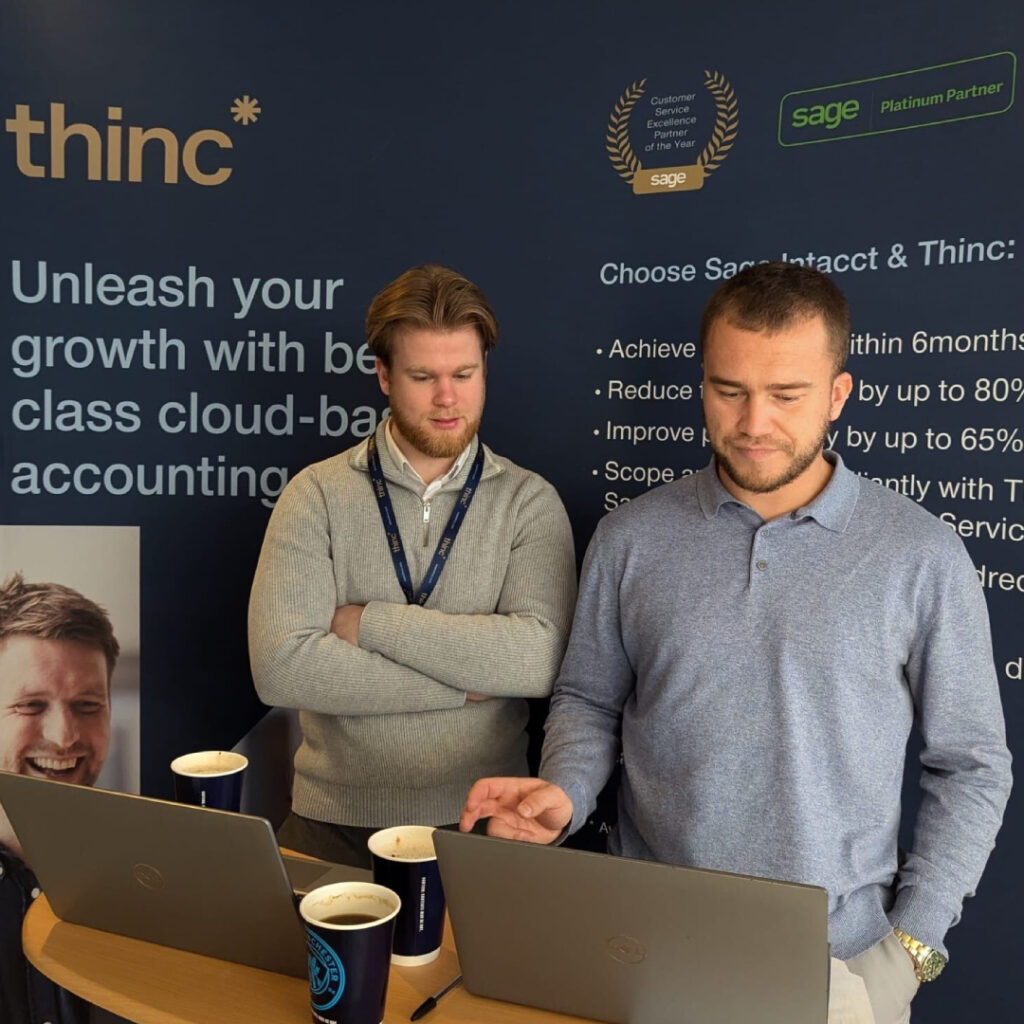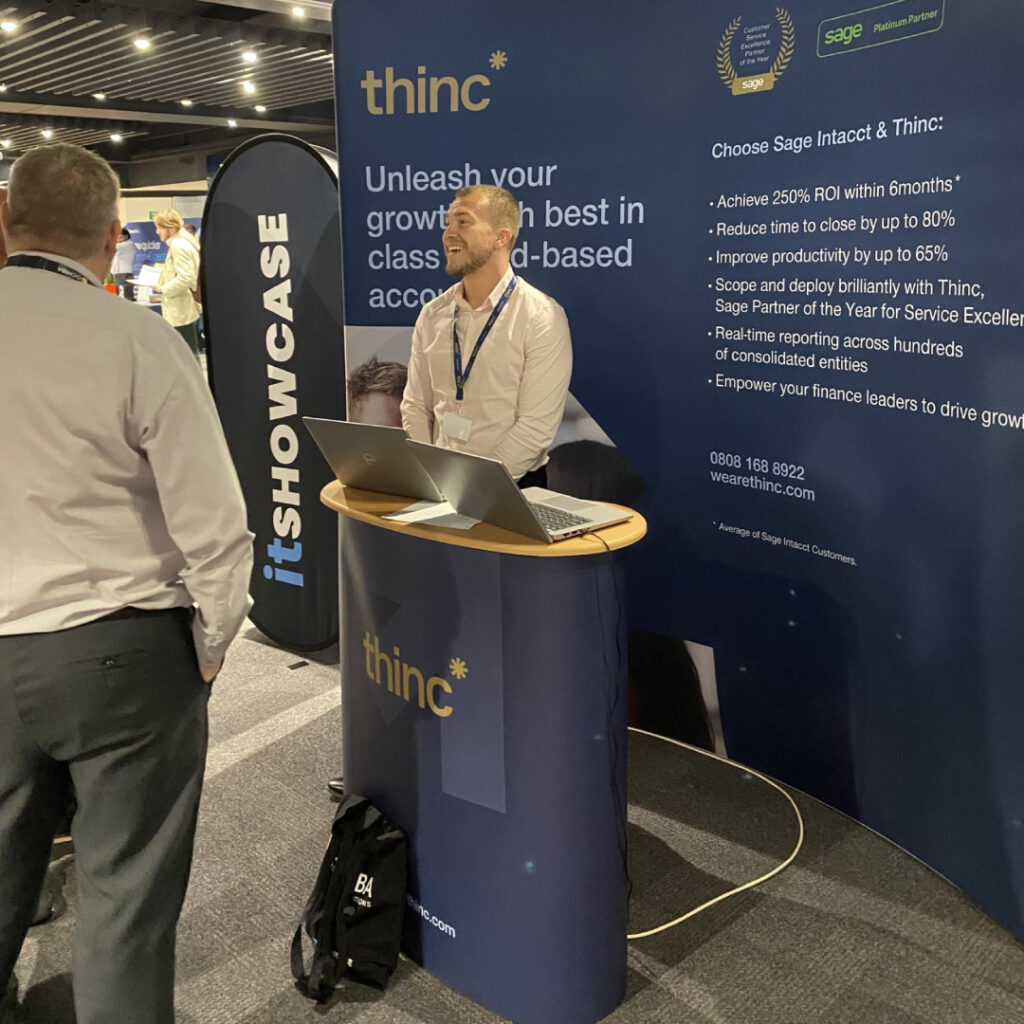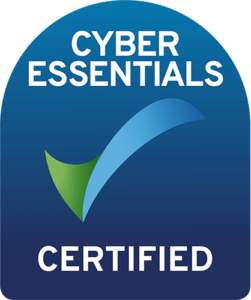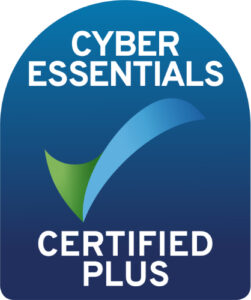Thinc insights
What are the biggest questions asked about ERP selection by SMEs?
What are your biggest questions about ERP selection? Here’s what finance and operations leaders tell us about the challenges they face when looking to scale their business.
Throughout the year, our consultants are on the road at events, meeting with business and finance leaders to discuss how our capabilities can support SMEs with growth, scalability and sewing together disconnected systems.
We sat down with consultants Ethan Jude and Joseph Ingle to unpack the common questions that they’re asked by the people we meet. They covered everything from what pains come with growth and scalability to how to choose the right partner.
Here’s what they had to say when asked about ERP software selection and finding an all-encompassing partner that will work closely with you to help you grow.

At Thinc, we carefully select the technologies we work with and we recommend to our clients, whether it’s the ERP solutions Sage 200 and SAP Business One, the best-in-class financial software of Sage Intacct, or the breadth of technologies that we use to integrate, secure and monitor your systems.
This gives us a unique, independent perspective that makes for a great conversation with SMEs seeking a solution to their challenges. Here are some of the most common.
This early-stage uncertainty is typical of this point in the buying process. There are so many options out there. It’s important for businesses to have that firm understanding of exactly what they need out of their new system before narrowing down their options.
We always suggest that a business has a defined understanding of what they’re looking to achieve from their business scaling, and how their IT systems and infrastructure is going to support that. Do all you can to achieve that understanding during the investigation phase.
We’re often asked about reporting – it’s a common theme. We support businesses from all industries, but they’ll often have moved to us and to a new system due to requiring better reporting. This is especially the case if a business has outgrown its entry–level system, like a Xero, QuickBooks or Sage 50 setup.
The reporting that these systems offer is limited, and Sage 200, Sage Intacct or SAP Business One are often the next sensible step for this. They’re systems that help with automating data entry, thus slashing that time taken exporting data into Excel. A new system can also provide better reporting dashboards through easy-to-build graphs, while also having an array of modules that can be added to support with data granularity in a way that isn’t possible with entry–level reporting systems. So, yes, a new system can certainly help to navigate those major pains that come with reporting.
We always recommend that, after you’ve evaluated your organisation’s needs and explored the ERP systems that can scale with your organisation, that you consider mapping out your requirements.
Always start by looking at growth – what are you looking to achieve in the next three to five years? What’s holding you back currently? What are the must-have features for your next system? Assess if you’re ready to implement your desired solution; do you have the internal resource for a project of this nature? Will data migration, staff training and integration with other tools be required? Then, look for an ERP system that fits your needs for scalability, flexibility and reporting capabilities, with a partner that is an expert in your industry, with a long-term partnership at the heart of how they operate.

We always tell people that ask this a rather simple answer: it depends. Timelines will depend on an organisation’s size, existing system complexity, customisation needs that have been mapped out for the new ERP system, along with data and other migration requirements. Here’s a general guide for implementation:
There are some additional considerations before starting an implementation. You’ll need to make sure that any ERP implementation that you carry out has a mix of technical and business resources. You’ll need a senior leadership champion, backing the project and ensuring it’s aligned with business goals. Then, you’ll need to make sure that there’s a cross-functional projects team in place – your top three priorities should be finance, operations and IT. Once all this has been coordinated, you’ll be well on your way to navigating the implementation process.
We get asked this question quite often after explaining timings associated with implementation. The best approach really depends on the size of your organisation and the complexities involved with any changes. We’ve worked with organisations that have implemented through these two methods:
You’ll roll out your ERP system in stages, starting with the core modules for core departments, such as finance. Then, gradually build around this, adding functions like project management, customer relationship management (CRM) and inventory.
Advantages include – lower risk of disruption, easier change management and spreads cost and resource demands over time.
Challenges include – a strong project team to ensure continuity, temporary integrations between old and new systems and a longer time before that full ROI and resource limitation is realised.
Advantages include – faster transition to a fully integrated system, no need to maintain old and new systems in parallel and there’s immediate access to all features and functionality.
Disadvantages include – high risk if issues arise during the go-live phase, greater pressure on staff to learn the system and it can be resource-intense and costly upfront.
We always encourage anyone that we speak with to have a clear vision of what their ERP rollout looks like.
Choosing the right ERP partner is as important as selecting the system itself. You’ll need to pick a partner with a proven track record. We’re often asked about how we’ve supported organisations of similar size, sector and complexity.
You’ll also need to assess their implementation approach – consider what we’ve already mentioned for this, and how the provider may fit with your plan. Also, gaining an idea of what training and ongoing support looks like is important. Your ERP implementation is a long-term partnership, so it’s crucial that the team is easy to work with, responsive and aligned with your organisational values. When it comes to choosing the right partner, be sure to pick one that can ensure successful adoption, minimal disruption and a long-term partnership.
Joseph Ingle (left) and Ethan Jude (right) voice how the itSHOWCASE unearths a number of common questions asked when it comes down to ERP selection.
Here at Thinc, we can work with you to gain a complete understanding of what you need to answer during the investigation phase. Through our experience and in-house expertise, we’ve been supporting companies of all sizes and sectors for over 30 years, so we know what to ask when in that investigation phase.
Through our experience in supporting businesses with adopting ERPs, we have a firm understanding of what major pains you may be looking to address with your ERP implementation. We can support you with scaling up and down based on specific requirements, no matter how popular or how niche.
We’re here to help you to make sure that your chosen ERP is the right one for you, being resource and budget friendly. We’ll always make sure that everything comes back to core functionality, scalability and integration requirements, providing best practice with our consultants and strategic advisors.
Thinc as an engaged partner is here to support with a structured approach to ERP implementation, taking the time to plan and train where appropriate. From data migration and system configuration, to testing and go-live preparation, our teams will be on hand to offer their insight.
A well-defined project rollout is vital for a smooth introductory period. As a strategic partner, Thinc is on hand to guide you through the process, revisiting your business goals and scope plans to have a faultless ERP rollout that supports your needs from go-live day.
To learn more about the conversations that our team have, or how we can support your teams in making that next step, check out the full conversation or get in touch today.
Related Topics
Do you have a question about your ERP selection?


Enter your details into the contact form below, and one of our experts will be in touch to arrange a time to speak.
If you’re an existing customer looking for support, please e-mail servicedesk@wearethinc.com, or visit our support page where you can download our remote support apps.